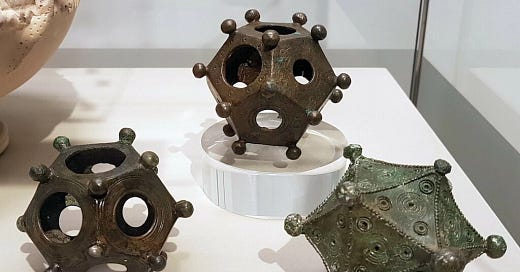What have we learned about the Dodecahedron?
Mathematicians know what a dodecahedron is. In geometry, it is a polyhedron shape with twelve flat surfaces. Those of us who are non-mathematically inclined, like me, would not know that. We should consider this shape, though, because it concerns one of the strangest mysteries in the history of the world.
Since 1737, and perhaps long before, little hollow metallic dodecahedron-shaped articles have been discovered under the surface of the earth. They have been excavated mostly in central Europe in such widely separated places as Germany, France, Spain, Hungary and Austria. One was even found at Hadrian’s Wall in England. Some small ones made of gold have also been found in southeast Asia, on the Maritime Silk Road.
On each of these objects, there are circular holes in each of the 12 faces and five globular knobs at the vertices of the pentagons. The material they are made from seems to be a copper alloy. The sizes range from 2 to 4 cm. A total of 116 of these strange objects have been found. There is no mention or sketch of them in any ancient documents. They are a complete mystery. A 20-sided icosahedron (lower right below) was also found and is now in a museum in Bonn, Germany
Some dodecahedrons have been found at archaeological sites which should provide clues to their use, but so far haven’t. Others have turned up in bazaars and antique shops as curios. Therefore these have no provenance to reveal where, when or how they were found.
So what are they? No one knows, although there has been plenty of speculation. Were they used for some sort of astronomical calculation, perhaps to determine the best time for spring or fall planting? Were they used as dies in a game, or for fortune-telling? The suggestion that they might be talismans worn around the neck fails because they are too big and lumpy to be worn comfortably. They may have been simply whimseys to pique the owners’ imagination.
What do you think they may have been?
Thanks to Phil Turcotte for suggesting this topic for consideration.




